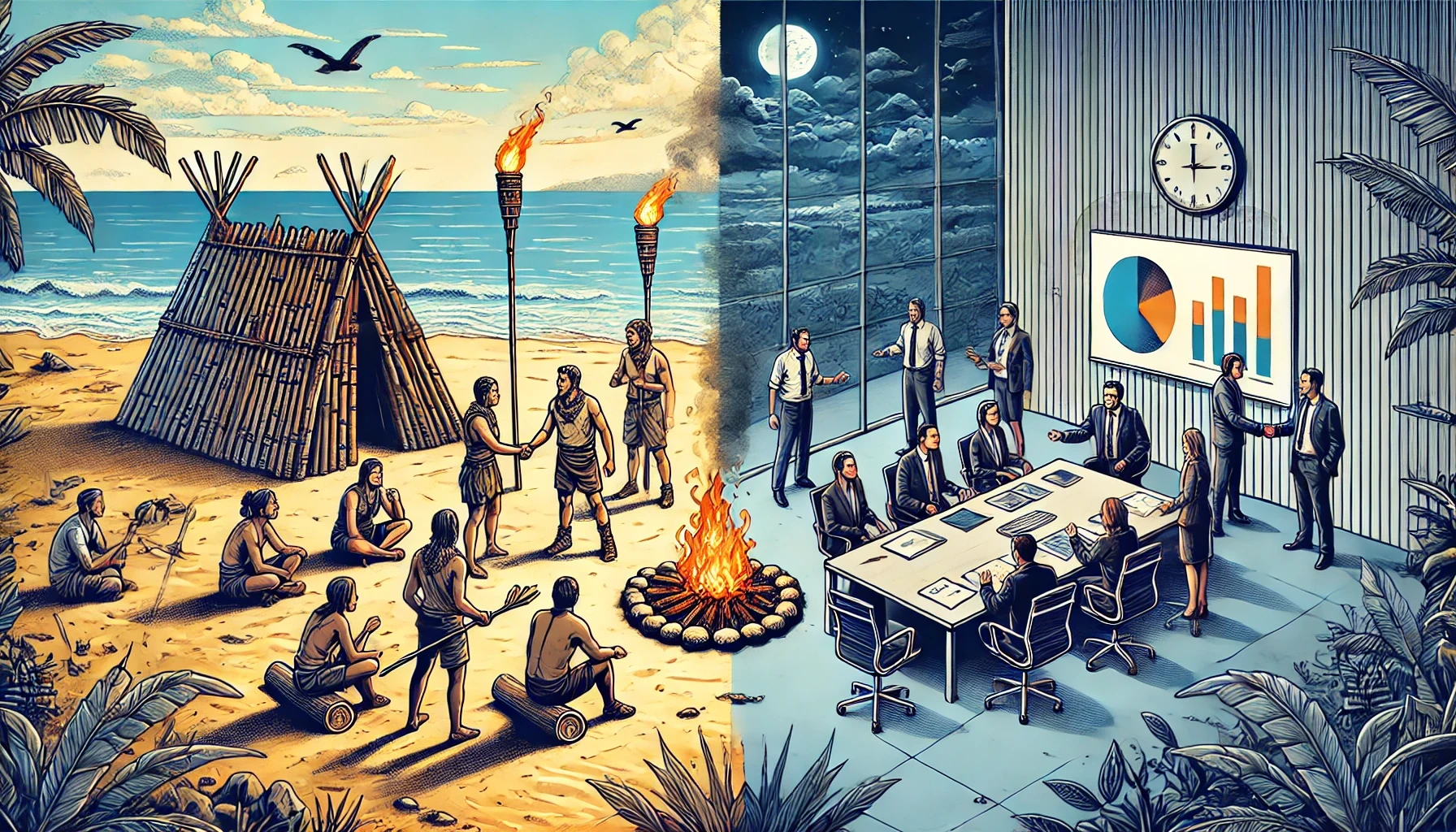

How the strategic principles of a reality TV show mirror successful business practices
The reality TV show Survivor is often described as a social experiment in strategy and human behavior. Stranded contestants must “outwit, outplay, outlast” each other for 39 days to win – a process that mirrors challenges in the business world. In both arenas, individuals navigate limited resources, intense competition, and the need to adapt under pressure.
Many strategic principles that lead to success on Survivor – leadership, adaptability, alliances, risk management, and resilience – have clear analogues in company and professional cultures. Below, we analyze each of these parallels with examples from Survivor and real-world business case studies, supported by psychological insights and research.
Leadership: Balancing Task and Relationship
Survivor Lesson
On Survivor, those who jump into a leadership role without building relationships often become early targets. A classic pattern is that a self-appointed “project manager” works feverishly to build shelter or gather food while neglecting social bonds – and ironically gets voted off first.
In one analysis of the show, hard-working tribe members focusing only on tasks were eliminated before the “slackers” who spent time chatting and bonding. The reason is simple: the social leaders on the beach were actually forging trust and alliances, which protected them from being voted out.
This underscores that effective leadership requires more than directive authority; it demands emotional intelligence and team-building. Research in group dynamics supports this: great leaders achieve goals and maintain relationships – “tasks and relationships are both essential in leadership.”
Business Parallel
In business culture, the same lesson applies. A manager solely focused on metrics and deadlines, without fostering trust or empathy, can alienate their team. Companies with high-performing cultures emphasize both performance and people.
Case Study: Microsoft’s Cultural Transformation
Microsoft’s CEO Satya Nadella famously shifted the company from a combative, internal competition mindset to a collaborative “learn-it-all” culture, encouraging growth and empathy over ego. That cultural turnaround, driven by leadership style, has been credited with revitalizing Microsoft’s innovation and morale.
Just as on Survivor a tribe’s morale and unity can determine its success in challenges, in organizations a leader who builds a supportive, values-driven culture will see better engagement and loyalty.
The takeaway: whether guiding a tribe or a corporate team, leadership is an exercise in influence and inclusion – aligning people toward a goal while making each member feel safe and valued.
Adaptability: Navigating Change and Uncertainty
Survivor Lesson
Adaptability is perhaps the most celebrated trait on Survivor. The host Jeff Probst introduced the very first season by telling contestants they “must learn to adapt or they’ll be voted off.”
Indeed, every episode brings new twists – a sudden tribe swap, a hidden immunity idol in play, an unexpected rule change – and the players who thrive are those who can pivot their strategy on a dime. For instance, if a dominant alliance collapses or a trusted ally is blindsided, a savvy contestant will quickly recalibrate, form new partnerships, or shift game plans to stay alive.
Winners often highlight their flexibility; as one Survivor motto goes, “plan long-term, but be ready to change plans overnight.” The Survivor format forces a balance between having a strategy and staying agile in execution.
Business Parallel
The business world is no less unforgiving to those who fail to adapt. In an era of rapid market disruption, companies must continuously evolve or risk obsolescence.
Case Study: Netflix vs. Blockbuster
A prime example is Netflix’s transformation from a DVD-by-mail service to a streaming powerhouse. When technology and consumer preferences shifted, Netflix embraced the change – investing in streaming technology early, revamping its business model, and even later producing original content. This organizational agility allowed Netflix to dominate an industry that once toppled Blockbuster. As one case study notes, Netflix “continuously adapt[ed] to market changes,” setting a benchmark for digital transformation.
In contrast, companies that failed to adapt – like Kodak, which stuck with film in the face of digital photography – illustrate how inflexibility can be fatal.
Adaptability is also a key component of resilience research. Business scholars define resilience as an organization’s “timely adaptation to both immediate and gradual changes in the business environment.”
The strategic parallel is clear: adapt or perish is the rule in both Survivor and business.
Alliances and Team Dynamics: The Power of Trust
Survivor Lesson
In Survivor, no one wins alone. From the outset, contestants scramble to form alliances – small teams whose members agree to protect each other and vote together. A strong alliance provides safety in numbers: if you have the majority on your side, you control the vote and can eliminate outsiders.
Example: Boston Rob’s Alliance Management
In Survivor: Redemption Island, Boston Rob Mariano forged an alliance and famously forbade its members from even talking one-on-one with those outside the group – an extreme but effective way to build loyalty by treating everyone else as a common enemy. His tight-knit alliance, bound by trust and a clear vision, carried him to victory.
More generally, alliances in Survivor are maintained by constant communication and reassurance; players “check in” with allies to quell paranoia and keep everyone on the same page. When alliances break, it’s often due to a loss of trust or someone seizing an opportunity to get ahead (the well-timed betrayal).
Thus, Survivor illustrates both the value of collaboration and the fragility of partnerships in a competitive environment.
Business Parallel
Professional cultures likewise hinge on the power of alliances – both internal teams and external partnerships. Within organizations, high-performing teams resemble Survivor alliances in their trust and mutual commitment.
Colleagues who build genuine relationships and have each other’s backs create a supportive culture that can weather challenges. Leaders are advised to cultivate this trust by being transparent and “checking in” regularly with team members (much as Survivor allies do), which leads to better loyalty and performance.
Case Study: Uber and Spotify Alliance
Externally, companies form strategic alliances to undertake projects that each party couldn’t accomplish alone. A textbook example is the partnership between Uber and Spotify: Uber wanted to improve riders’ experience with music, and Spotify had the streaming technology. By teaming up, Uber provided the user base and Spotify the tech, creating a mutually beneficial service neither could have built alone.
In business, as in Survivor, the strongest alliances are those where both parties benefit and share common goals.
However, there’s also a parallel in knowing when to re-evaluate alliances. Just as a Survivor player might decide to “flip” on an alliance that no longer serves their path to the end, companies must periodically assess their partnerships and team dynamics.
The key is that whether you’re on a tropical island or in a boardroom, relationships built on trust, open communication, and aligned interests are a cornerstone of survival and success.
Risk Management: Balancing Bold Moves and Caution
Survivor Lesson
Every move in Survivor is a risk calculation. Should I vote off a strong ally before he turns on me? Should I play my hidden immunity idol now or save it? Bold, risky moves can yield big rewards (such as blindsiding a major threat), but they can also backfire spectacularly.
Conversely, playing too cautiously can be a slow death sentence – if you never take initiative, you may end up carried to the end with no resume, only to lose the final jury vote.
As one entrepreneur observed, “Survivor is all about taking risks — forming alliances, hunting for immunity idols, and deciding when to play them.” The winners tend to be those who take calculated risks at the right time.
For instance, a contestant might risk angering someone by flipping alliances in order to break up a rival power bloc, calculating that the long-term benefit outweighs the immediate fallout.
On the other hand, a notorious example of poor risk management on Survivor is overplaying: contestants who made one move too many (a premature blindside or a needless gamble) often found themselves voted out once they burned trust.
Thus, successful players treat risk like a resource to be managed – they neither shy away from it nor gamble aimlessly, but rather weigh the odds and potential payoff of each decision.
Business Parallel
Entrepreneurs and businesses face a similar tightrope. Pursuing innovation or growth invariably involves risk, but failing to take risks can mean stagnation. As Facebook’s founder learned early on, “in a world that’s changing so quickly, the biggest risk you can take is not taking any risk.”
In corporate strategy, this translates to a need for bold vision. Companies that never venture beyond their comfort zone – sticking only to legacy products or markets – may survive in the short term but eventually lose out to more daring competitors.
Yet, uncalculated risk is just as dangerous in business as it is in Survivor. That’s why modern enterprises emphasize risk management: identifying potential threats and opportunities, analyzing them, and making informed decisions.
Case Study: Amazon’s AWS Gamble
When Amazon decided to launch Amazon Web Services (AWS), it was a significant risk – entering a new industry (cloud computing) far from its core online retail business. Many questioned the move, but it was a calculated risk based on the growing need for cloud infrastructure. That bold bet became one of Amazon’s biggest growth drivers.
In contrast, think of a company like Kodak, which famously avoided the risk of pivoting to digital photography (despite inventing one of the first digital cameras) for fear of cannibalizing its film business. That reluctance to take a necessary risk proved fatal when digital tech left Kodak behind.
The optimal approach in both contexts is strategic risk management – know when to stick with the safe choice and when to strike out boldly.
Resilience: Outlasting and Bouncing Back
Survivor Lesson
Survivor is as much a mental and physical endurance test as it is a strategy game. Contestants are subjected to hunger, fatigue, and the stress of social conflict. The ability to persevere through hardships – to stay focused and positive after nights of rain on a bamboo shelter or after being blindsided by allies – is often what separates the winner from those who quit or implode.
In psychological terms, Survivor demands resilience and grit. Research on high achievers has found that grit (passion and perseverance) and resilience (adaptability to change) are key predictors of success.
Example: Chris’s Comeback
A famous example is in Survivor: Edge of Extinction, where a contestant voted out on Day 8 (Chris) refused to give up, endured on a punitive exile island, earned his way back in on Day 35, and ultimately won the game. His journey epitomized resilience – the capacity to bounce back from failure and still triumph.
Even in regular seasons, many winners face moments of adversity (like losing allies or facing a minority position) but find ways to regroup and push forward. This quality of mental toughness and flexibility under pressure is highly prized; as the saying goes, Survivor isn’t just about outwitting and outplaying, but also outlasting.
Business Parallel
In the business world, resilience is equally vital. Companies encounter crises, disruptions, and failures regularly – from economic recessions to supply chain breakdowns to global pandemics.
Organizational resilience refers to a company’s ability to absorb the shock, recover, and even come out stronger. A useful definition is “the ability of an organization to anticipate, prepare for, respond to, and recover from adverse events… it’s about adaptability and the strength to bounce back.”
Case Study: Pandemic Adaptations
Companies that had prepared contingency plans and adaptive processes proved far more resilient during events like the COVID-19 pandemic than those that were caught off guard. For example, many restaurants and retailers that quickly pivoted to online ordering, curbside pickup, or other creative solutions in 2020 managed to survive or thrive, whereas others that couldn’t adapt had to shut doors.
Resilient organizations typically foster a culture of learning and flexibility – they treat setbacks as learning opportunities and encourage problem-solving at all levels. This parallels Survivor’s resilient players who treat getting blindsided not as game over but as a wake-up call to adjust their play.
In sum, resilience in business means creating a company that can outlast hardships, much as the Sole Survivor is the one who withstood everything thrown at them.
Conclusion: Outwitting, Outplaying, Outlasting in Business
Though Survivor is a televised game and business is real life, the strategic parallels are striking. Both domains involve people working together (and at times against each other) under pressure, requiring a mix of savvy strategy and social finesse.
Key Strategic Parallels:
- Leadership: Culture and relationships can trump raw efficiency – a lesson every manager should heed in building team cohesion.
- Adaptability: Markets and workplaces, like the game’s twists, change rapidly, favoring those who pivot rather than cling to old plans.
- Alliances: Trust and collaboration are powerful assets, whether you’re forging a voting bloc on an island or a cross-functional team in an office.
- Risk Management: Both contexts call for courage balanced by caution – the wisdom to take bold action when warranted, but always with a calculated understanding of consequences.
- Resilience: The endurance to withstand setbacks and come back stronger is essential in both arenas.
Professional and company cultures can draw direct inspiration from Survivor. For instance, promoting open communication and trust in a company mirrors the ally-building on Survivor that keeps tribes strong. Encouraging a mindset that treats challenges as opportunities to innovate is akin to the Survivor mentality of adapting to any twist.
Even the endgame of Survivor – persuading a jury of peers to reward you – has a business parallel in maintaining one’s reputation and integrity; ultimately, success is decided by people’s trust and perception of you.
By examining Survivor through a strategic lens, we see a microcosm of competitive strategy and team psychology. It reinforces lessons backed by management science and psychology research, but in a visceral, entertaining way.
As one business writer noted, the skills and traits that win Survivor are “crucial in the business world” – a testament to how art can imitate life. In both Survivor and business, those who lead wisely, adapt quickly, cultivate allies, manage risk, and demonstrate resilience are the ones most likely to thrive.
Sources
Leadership Sources
- Jeff Probst’s introduction to Survivor (2000), as quoted in Psychology in Action (Outwit, Outplay, Outlast: The Psychology of Survivor).
- Malavenda, P. (2012). Survivor Leadership – The Leadership Primer, on balancing task-oriented and socio-emotional leadership (Survivor Leadership).
- Komives, S. (2007). Exploring Leadership – Definition of effective leadership (via Malavenda) (Exploring Leadership).
Adaptability Sources
- Oxford Executive (2024). Case Study: Netflix’s Transition to Streaming – on agility and continuous adaptation (Netflix’s Transition from DVD Rental to Streaming).
- optYOUmize Blog (2023). “How Survivor Mirrors Entrepreneurship” – parallels in risk-taking, adaptability, etc. (How The Reality TV Show “Survivor” Mirrors Entrepreneurship).
Alliances & Team Dynamics Sources
- Formstack Blog (2017). “Outwit, Outplay, Outlast: Bringing ‘Survivor’ Tactics into the Workplace.” – on alliance building, trust, and team check-ins (Business Lessons Learned from ‘Survivor’).
- Investopedia (2023). Explanation and example of strategic alliances (Uber & Spotify) (Strategic Alliances: How They Work in Business).
Risk Management Sources
- Wharton Online (2021). “Is Risk-Taking Key to Entrepreneurial Spirit?” – on risk, “biggest risk is not taking any” (Is Risk-Taking Behavior Key to Entrepreneurial Spirit?).
- MIT Sloan (2022). “Risk Intelligence and the Resilient Company.” – on resilience as adaptation in real time (Risk Intelligence and the Resilient Company).
Resilience Sources
- Stanton, M. (2023). “Grit, Resilience, and Success.” – psychology of grit and resilience (Medium) (Grit, Resilience, and Success).
- CTRL-Disrupt (2023). “The Intersection of Resilience and Risk Management.” – defines organizational resilience and adaptive capacity (The Intersection of Resilience and Risk Management).





